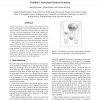Free Online Productivity Tools
i2Speak
i2Symbol
i2OCR
iTex2Img
iWeb2Print
iWeb2Shot
i2Type
iPdf2Split
iPdf2Merge
i2Bopomofo
i2Arabic
i2Style
i2Image
i2PDF
iLatex2Rtf
Sci2ools
105
Voted
CVPR
2005
IEEE
2005
IEEE
Visibility Constrained Surface Evolution
The problem of feature-based surface reconstruction is considered in this paper. Our main contribution is the ability to handle visibility constraints, obtained from the projections of points, curves and silhouettes, in the surface fitting process. While traditional methods often ignore such information, we show that visibility constraints not only give better initial surface estimates and faster convergence, but also provide an important cue for determining surface topology. The problem is cast as a variational problem with constraints within the level set framework. It is shown how to evolvethe surface without violating the visibility constraints using methods from variational calculus. Applications of the theory are detailed for a number of important cases of geometric primitives: points, curves and visual hulls. Several experiments on real image sequences are given to demonstrate the performance of the approach.
Computer Vision | CVPR 2005 | Feature-based Surface Reconstruction | Initial Surface Estimates | Surface Fitting Process | Surface Topology | Visibility Constraints |
Related Content
| Added | 12 Oct 2009 |
| Updated | 12 Oct 2009 |
| Type | Conference |
| Year | 2005 |
| Where | CVPR |
| Authors | Jan Erik Solem, Fredrik Kahl, Anders Heyden |
Comments (0)

